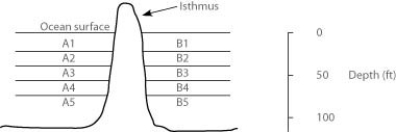Multiple Choice
Use the following description to answer the question.
In the oceans on either side of the Isthmus of Panama are 30 species of snapping shrimp; some are shallow-water species, others are adapted to deep water. There are 15 species on the Pacific side and 15 different species on the Atlantic side. The Isthmus of Panama started rising about 10 million years ago. The oceans were completely separated by the isthmus about 3 million years ago.
In the figure, the isthmus separates the Pacific Ocean on the left (side A) from the Atlantic Ocean on the right (side B) . The seawater on either side of the isthmus is separated into five depth habitats (1-5) , with 1 being the shallowest.
The Panama Canal was completed in 1914, and its depth is about 50 feet. After 1914, snapping shrimp species from which habitats should be most likely to form hybrids as the result of the canal?
A) A5 and B5
B) A3 and B3
C) A1 and B1
D) A1-A3 and B1-B3 have equal likelihoods of harboring snapping shrimp species that can hybridize.
Correct Answer:

Verified
Correct Answer:
Verified
Q2: Use the following description to answer the
Q3: A narrow hybrid zone separates the toad
Q4: House finches were found only in western
Q5: A small number of birds arrive on
Q6: How are two different species most likely
Q8: How is length of time for speciation
Q9: Macroevolution is _.<br>A) the same as microevolution,
Q10: According to the biological species concept, for
Q11: Among known plant species, which of these
Q12: Suppose that a group of male pied